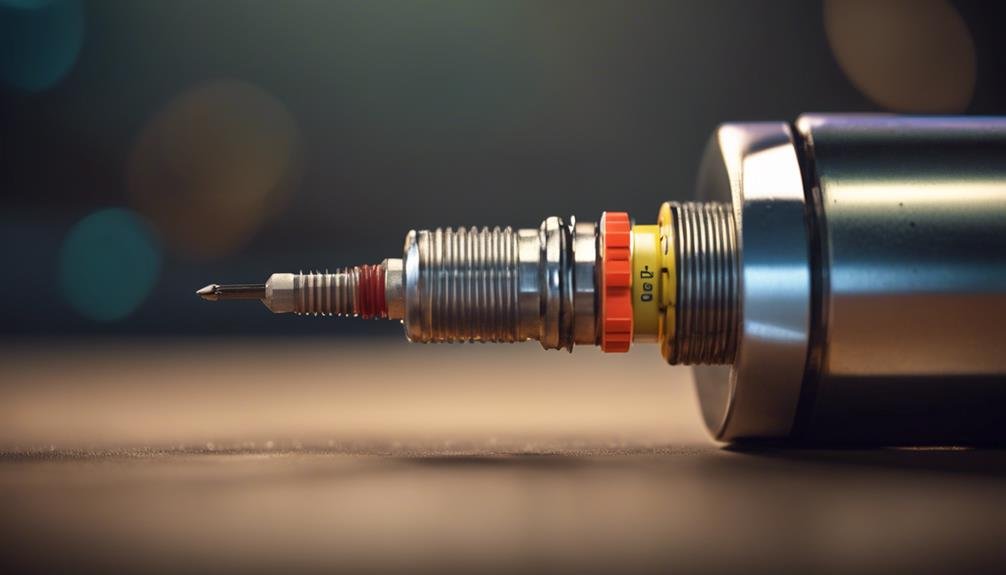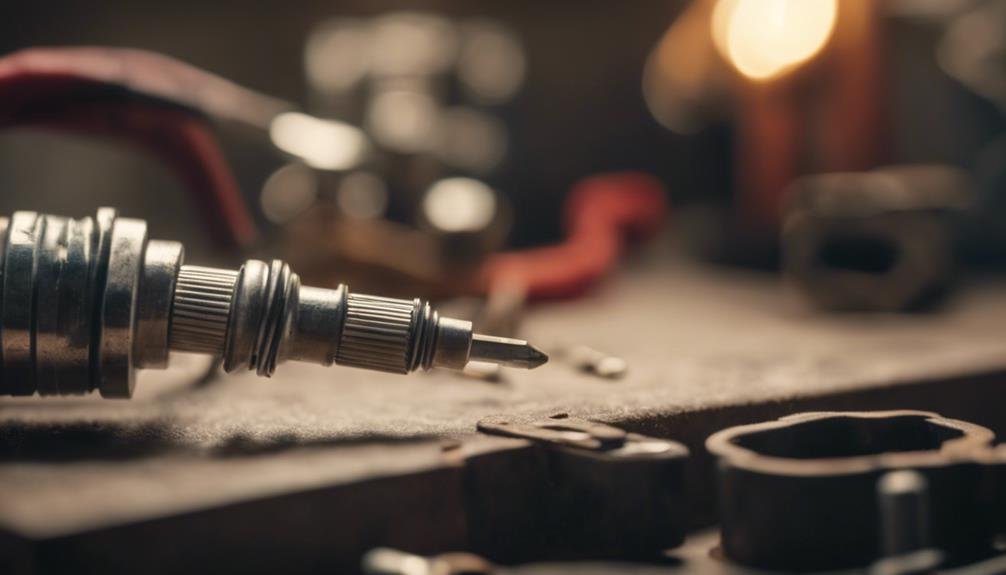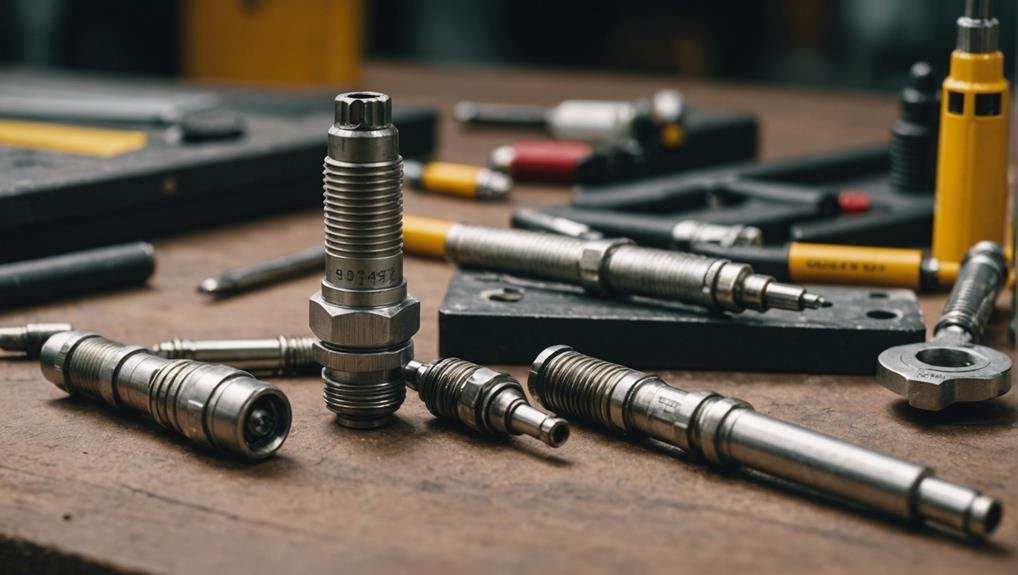When gapping spark plugs, keep in mind that accurate gap settings are essential, as they determine the voltage required for spark creation. Refer to your owner's manual or catalog to find the correct gap setting, which typically ranges between 0.028 and 0.060 inches. Utilize a gap gauge to measure and adjust the gap, ensuring smooth engine operation and peak performance. Be cautious, as narrow gaps can cause weak sparks, while wide gaps can lead to misfires. Adjust the ground electrode carefully and double-check the gap against specifications. Get it right, and you'll be on your way to top-notch engine performance – and there's more to discover on this critical process.
Key Takeaways
- Consult the owner's manual or catalog to find the recommended spark plug gap setting for your vehicle.
- Use a spark plug gap tool or feeler gauge to accurately measure the gap and make adjustments.
- Adjust the ground electrode carefully to avoid damaging the spark plug or electrode.
- Double-check the gap setting against the recommended specification to ensure proper engine performance.
- Regularly check and adjust the spark plug gap to prevent engine damage and maintain optimal performance.
Understanding Spark Plug Gap Importance
Because spark plugs are responsible for igniting the fuel in your engine, the gap between the center and ground electrodes plays a critical role in determining the voltage needed to create a spark.
You mightn't realize it, but spark plug gapping is important for peak engine performance. A proper gap ensures the correct voltage, which in turn affects combustion efficiency. If the gap is incorrect, it can lead to engine issues like misfires and power loss.
Adjusting the gap to the correct setting is necessary, as specified by the vehicle's manufacturer. When you gap spark plugs correctly, you're ensuring the spark plug gap is crucial for efficient fuel ignition.
A narrow gap can lead to weak sparks, while a wide gap can cause misfires. By understanding the importance of spark plug gap, you'll appreciate the need to adjust the gap to achieve the correct spark plug gap for your vehicle.
Finding the Correct Gap Setting
You'll need to consult your owner's manual or a reliable catalog to find the correct spark plug gap setting for your specific vehicle, as it varies widely from one make and model to another. Gap settings typically range between 0.028 and 0.060 inches, depending on the vehicle's specifications.
Accurate gap setting is vital for excellent engine efficiency and performance, as it affects combustion efficiency, engine power, and fuel economy. To guarantee proper ignition and combustion, double-check and confirm the recommended gap setting for your specific vehicle.
When adjusting the gap, use a gap gauge to measure the distance between the center and ground electrodes. You'll need a tool to adjust the gap, ensuring the contact points are clean and free of debris. If the gap is too big, it can lead to misfires, while a gap that's too small can cause poor engine performance.
Your goal is a properly gapped spark plug, which will ensure your engine runs smoothly and efficiently. By following the recommended gap setting, you'll be able to achieve excellent performance and fuel efficiency.
Gapping Spark Plugs Step-by-Step

Now that you've confirmed the recommended gap setting for your vehicle, take out your gap tool and spark plug to begin the gapping process.
Refer to your owner's manual if you need a refresher on the specified gap size. Using your gapping tool or feeler gauge, measure the gap, which is the distance between the center electrode and the ground electrode.
If the gap isn't set correctly, make minor adjustments by carefully bending the ground electrode to increase or decrease the distance. Be cautious not to touch the electrodes with your tool to avoid damaging the spark plug.
As you make adjustments, double-check the gap to make sure it matches the recommended specification. Remember, the gap size affects the spark plug's firing temperature and engine performance. By following these steps, you'll be able to accurately set the gap and optimize your engine's function.
Avoiding Incorrect Gap Consequences
By setting the spark plug gap correctly, you've taken a significant step in avoiding the consequences of an improperly gapped plug, which can lead to a range of engine issues. A spark plug gap that's too wide can stress ignition components, while a gap that's too narrow can reduce engine power. Improper gap adjustment can lead to misfires, poor fuel efficiency, and even engine damage.
On the other hand, essential gap adjustment is vital for efficient combustion and peak engine performance. Remember, the ideal spark plug gap size varies based on the vehicle's manufacturer specifications, so be sure to consult your owner's manual or the manufacturer's recommendations.
Regularly checking and adjusting the spark plug gap helps prevent engine damage and ensures smooth operation. By doing so, you'll be able to maintain efficient combustion, reduce the risk of engine issues, and extend the lifespan of your ignition components.
Tools and Techniques for Gapping

To guarantee accurate gap adjustments, it's important to have the right tools, including a spark plug gapping tool, feeler gauges, or wire-type gap gauges that can measure the gap to the manufacturer's specifications. When working with spark plugs, especially those with precious metals like iridium or platinum, precision is key to efficient engine performance and efficiency.
| Gapping Tool | Description |
|---|---|
| Spark Plug Gapping Tool | Necessary for adjusting the gap to the manufacturer's specifications |
| Coin-Style Gap Tool | Provides a simple and effective way to adjust the spark plug gap |
| Feeler Gauges/Wire-Type Gap Gauges | Measures the spark plug gap accurately |
You can find these tools at auto parts stores like AutoZone, which offers a range of products to help with maintaining the correct gap. When choosing a gap tool, make sure it fits closely to the spark plug gap to ensure accurate adjustments. By using the right tools and techniques, you'll be able to achieve consistent and precise gap adjustments, which are crucial for efficient engine performance and efficiency.
Common Spark Plug Gap Mistakes
When you neglect to check and adjust the spark plug gap, you're inviting engine troubles, including misfires and poor performance. It's important to avoid common mistakes that can lead to decreased fuel efficiency and power loss.
Here are some common spark plug gap mistakes to watch out for:
- Using the wrong tool: Avoid using pliers or other makeshift tools to gap your spark plugs. Instead, use a spark plug gap gauge to guarantee accurate measurements.
- Applying too much pressure: When gapping your spark plugs, use gentle pressure to avoid damaging the electrodes. Apply too much pressure, and you risk damaging the spark plug.
- Not checking the gap regularly: Spark plugs need to be gapped regularly to ensure top engine performance. Failing to do so can lead to misfires and poor engine performance.
- Gaping without measuring: Don't gap a spark without measuring the gap beforehand. Use a gap gauge to measure the gap and adjust accordingly.
Frequently Asked Questions
Do Spark Plugs Have to Be Perfectly Gapped?
You might think spark plugs need to be perfectly gapped, but they don't; however, the right gap is essential for top-notch engine performance, and incorrect gaps can lead to misfires and poor fuel economy.
How to Properly Set Spark Plug Gap?
You're wondering how to properly set the spark plug gap. Start by consulting your vehicle's manual for the recommended gap size, then use a gap gauge to measure and adjust the electrode to achieve the perfect fit.
How Much Do I Gap My Spark Plugs?
You're wondering how much to gap your spark plugs – check your owner's manual or manufacturer's specs for the recommended gap setting, as it varies by vehicle, but typically falls between 0.028 and 0.060 inches.
What Is the Rule of Thumb for Spark Plug Gap?
You're wondering what the rule of thumb is for spark plug gap. Well, you should follow the manufacturer's recommended specifications, as gap size varies by engine type and configuration to guarantee peak performance.
Conclusion
By now, you've learned how to properly gap spark plugs, ensuring your engine runs efficiently and effectively.
Remember, incorrect gap settings can lead to poor performance, decreased fuel efficiency, and even engine damage.
Take the time to get it right, and your vehicle will thank you.
With the correct tools and techniques, you'll be well on your way to maximizing your engine's potential.
